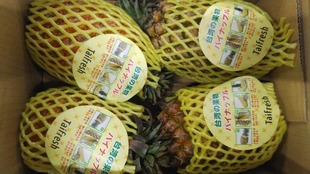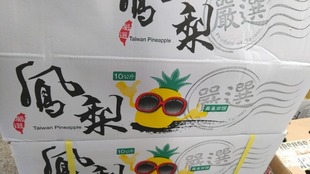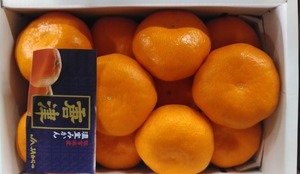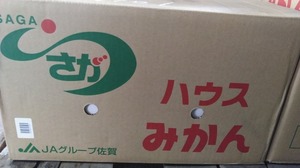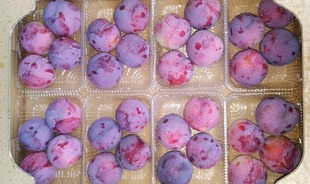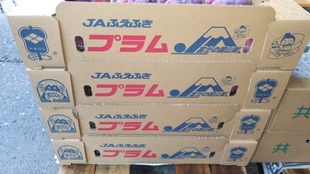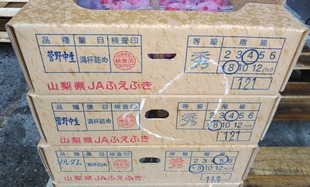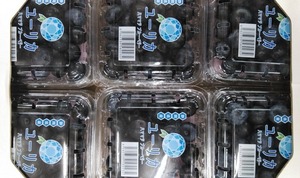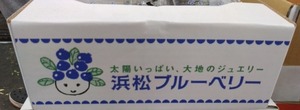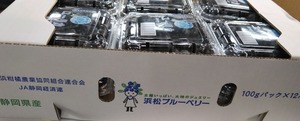Agriculture in Tokachi was often hit by poor harvests, which coincided with the economic downturn, and it seems that there was no shortage of people leaving farming. However, in 1914, with the outbreak of World War I and food shortages in Europe, Obihiro saw an increase in the export of legumes via Otaru Port due to the opening of the Kushiro Line (currently the Nemuro Main Line). As a result, there was a bean boom. I have heard that pioneer farmers who were previously self-sufficient are now able to engage in farming with confidence. At the same time, the scale of farming continued to expand with the shift from human power to animal power using horses, and agriculture began to see further progress.
【Product name】
Taisho make queen
【Type】
Solanum tuberosum L.
【Wholesale area】
Taisho Honcho, Obihiro City, Hokkaido (JA Obihiro-Taisho)
【Origin of name】
It seems that it was named after the queen who was chosen for the medieval spring festival (May Day: worker's festival held all over the world).
【Major features】
大正「大亨以正, 天之道也」: 大いに亨(とほ)りて以て正しきは, 天の道なり,「すべて滞りなく順調に運び正しさを得る」. Taisho Shrine (Amaterasu Okami): February 1921 Volunteers of Satsunai Village consulted, and in July 1922 the shrine was built with local resident's wealth, and the shrine was called Amaterasu Okami, and a ceremony was held under the name of Koshin Shrine. bottom. On May 1, 1926, due to the change of village boundaries, the villagers united and aspired to apply as a village shrine. On March 10, 1930, an application was made to change the name of the shrine to Taisho Shrine, and on May 17, 1930, it was approved. From the prefectural governor with a prefectural ordinance based on an imperial decree, those appointed to accept offerings of food, alcohol and gifts of monery wrapped at the prayer festival, the Niiname Festival (ceremonial offering to the deities by the Emperor of newly-harvested rice), and the annual festival A shrine dedicated to in paper called heihakuryo). The opening of the Hiroo Line in 1929 interfered with worship, so it was moved to its current location in 1934. Currently, it is revered as a guardian deity of the region, as a god of child rearing, performing arts, and good luck. Trademark Registration No. 5051632, Taisho Chinese yam, right holder: Obihiro Sei Agricultural Cooperative, Designated Goods or Designated Services, Obihiro City, Hokkaido Taishohoncho, Taisho Town, Aikoku Town, Showa Town, Kofuku Town, Sakuragi Town, Itaira Town, Izumi Town, Nakajima Town, Makubetsu Town, Nakagawa District Section of village Komai, Chinese yam produced by cooperative members who farm in the Sakae and Mikawa areas. The history of Taisho Chinese yam cultivated in the Obihiro Taisho area of Tokachi is about 40 years. Cultivation started with 3 producers, and now 76 producers are planting 200 ha. In order to deliver high-quality “Taisho Chinese Yam” to our customers, all producers work together to ensure thorough cultivation management. "Taisho Chinese Yam" is not only shipped domestically, but also exported to Taiwan and the United States. JA Obihiro Taisho is located 17 km south of the center of Obihiro City, Hokkaido, and has Obihiro Airport, the gateway to Tokachi. This is the area with the most blue skies and clear skies in Japan. The terrain is flat, and the arable land is mostly volcanic, with some alluvial soils. The Taisho region is known as "the hometown of Taisho May Queen (potatoes) and Taisho Kintoki beans.'' The main crops are wheat, sugar beets, potatoes, and beans. Yam is one of the local specialties along with potatoes and beans. It is an upland dairy farming area that includes vegetables. In this area, the production of edible potatoes (May Queen) has been thriving for a long time, and on the other hand, it was also a battle with potato common scab, the natural enemy of edible potatoes. This disease is affected by the acidity (pH) of the soil, and it is said that the higher the pH, the higher the possibility of contracting the disease. Therefore, it seems that the application of calcareous materials to neutralize the soil was less than in other regions. This situation has continued for many years, and in recent years the yield of various crops has been sluggish. As a result, about 70% of the 1,000 brushes analyzed in fiscal 1997 had a pH of less than 5.5 (very strongly acidic), and 20% of the fields had a pH of less than 5.0, which is unsuitable for growing crops. A drunken person is revealed to be in a difficult situation. In order to solve this urgent problem, our cooperative requested the cooperation of the Tokachi Chubu District Agricultural Improvement and Extension Center, Obihiro City Agricultural Promotion Public Corporation, and the Tokachi Federation of Agricultural Cooperatives to form the Taisho Soil Diagnosis Project Team formed. In the following year, as a project in 1998, we conducted soil analysis of about 900 points, and held a demonstration exhibition to confirm the effect of lime application in sugar beet fields so that producers could see and feel the local fields. It seems that they installed it in 12 fields and gave a technical improvement class in the blue sky workshop on site. In addition, it seems that they have been trying to improve farming techniques by conducting surveys on the effects of high and low pH on potatoes, wheat protein content surveys, and questionnaire surveys, and disseminating them to producers at conferences, seminars, etc. Streptomyces spp.: A disease whose occurrence is increasing with the alkalinization of soil. Light brown to grey-brown crusty lesions are formed on the surface of the tuber, which are of different sizes and slightly raised in the peripheral part and slightly depressed in the central part. The tissue under the lesion is pale brown and slightly rotten. This symptom is typical of this disease and is called common scab. Deeply sunken large deep scabs are often formed like the scars of feeding damage of molasses, and there seems to be raised scabs in which lesions swell like cushions. On the other hand, there is russet scab in which superficial lesions become network fissures. This is also known as tortoise shell disease. In other symptoms, grayish white powder (mycelia, spores) is seen in the lesions of tubers immediately after digging. It does not affect the yield, but if it occurs frequently, it seems to greatly reduce its value as food. In addition, according to NARO's verification, there are measures such as seed potato treatment, but fundamental measures such as soil disinfection are not taken except for some small farms in Honshu where the unit price of produce is relatively high. Apparently not. On the other hand, in the Kyushu region, which is centered on the remote islands of Kagoshima Prefecture, the application of rice bran has traditionally been practiced at the private level as a countermeasure against potato scab. Is scientifically unexplained. Therefore, we have scientifically verified the suppressive effect of rice bran on scab disease, and clarified the disease suppression mechanism. In 1999, the Basic Law on Food, Agriculture and Rural Areas was enacted, and a new agricultural policy started. Since the Basic Plan for Food, Agriculture and Rural Areas was enacted in 2000 under the new Basic Law, the basic plan has been reviewed every five years. In addition, since the formulation of the "Basic Plan for Redevelopment of Rural Areas in Obihiro City" in 1971, Obihiro City's plan for agricultural promotion has been the "5th Obihiro City Basic Plan for Agriculture and Rural Areas" formulated in 2010. It is formulated as a guideline for agricultural promotion in Motoichi while keeping an eye on various issues in each era. The environment surrounding agriculture is undergoing major changes, such as the declining population, the acceleration of economic globalization and technological innovation, and climate change, and is expected to become even more severe in the future. In addition to responding appropriately to changes in the environment surrounding agriculture and farming villages, the city's agriculture will continue to grow in the future, based on the government's "Basic Plan for Food, Agriculture, and Rural Areas" and the Hokkaido Government's "Hokkaido Agriculture and Rural Development Promotion Plan." For the sustainable development of rural areas, medium-to long-term. It seems that it will be formulated as a guideline to promote measures from a different perspective. The period of the plan will be 10 years from FY2020 to FY2029, and it will be reviewed as necessary based on changes in the situation surrounding agriculture and rural areas and the progress of measures. This plan was formulated in line with the 7th Obihiro City Comprehensive Plan as a field plan that indicates the direction of measures and goals for the next 10 years regarding the promotion of agriculture and forestry, based on changes in the environment surrounding agriculture and rural areas. It seems that it was in 1948, soon after JA was founded, that JA Obihiromasa began to grow May Queen in earnest. For more than 70 years since then, he has been engaged in selecting excellent seed potatoes, improving the cultivation techniques of producers, and carrying out PR activities. Today, the planted area is 1,256 ha, and it has grown into a large production area that produces about 37% of Hokkaido's May Queen Potatoes, and has received high praise from the market nationwide. Shipped 25,000 tons, harvested from August to September. Shipped from August to March. Regional collective trademark. Taisho May Queen potatoes (trademark registration No. 5051631): Reduced the amount of pesticides used since 2003. Stem and leaf chopper treatment: During the yellowing period (ripening period) of potato stems and leaves, the above-ground stems and leaves are mechanically treated to enable timely harvesting. JA Taisho Obihiro Top Brand―It operates its own fertilizer factory and supplies producers with fertilizer suitable for the region. With a feature that there is little variation in quality for half a year with great care from sowing to harvesting work. It is due to the excellent professional skills cultivated over many years by professional producers using fertilizers that are suitable for the soil. It is located almost in the center of the Tokachi region in eastern Hokkaido. It is the center of the Tokachi region(Mainly in the agricultural industry, 1 city 16 towns 2 villages)and plays a role as an agricultural product accumulation area and a commercial city. Full-scale development began in 1883. The history of systematic urban formation such as a grid-shaped road network. It is the foundation of our predecessors that we can experience both the ease of living and the richness of nature. The reason for Tokachi's core city. The self-sustaining development of local regions will depend on taking advantage of the potential of cities and, from a wider-ranging perspective, seeking forms of development whereby the merits of agglomeration spill over into peripheral areas, while also fostering key cities to form the core of regional economies. Article 67 In addition to what is prescribed in the main clause of the preceding Article, affairs which are specified as those to be determined by prefectures in this Act and are specified by a Cabinet Order shall be determined by designated cities set forth in Article 252-19, paragraph (1) of the Local Autonomy Act (Act No. 67 of 1947) (hereinafter referred to as "designated cities") or by core cities set forth in Article 252-22, paragraph (1) of the same Act (hereinafter referred to as "core cities") from designated cities or core cities (hereinafter referred to as "designated cities, etc.") pursuant to a Cabinet Order. In this case, the provisions of this Act concerning prefectures shall apply to designated cities, etc. as the provisions concerning designated cities, etc. The area of Obihiro City is 619.34 square kilometers, and the southwestern part is occupied by the Hidaka Mountains such as Mt. Tokachiporoshiri (1,846 m)(日高山脈襟裳国定公園(a national park in Hokkaido called Hidaka Sanmyaku Erimo National Park)ーIt boasts an area of about 10% of the city area.). The flat land in the center and northeast, which occupies about 60% of the city area. About half is one of the largest large-scale management in Japan: Dairy and upland farming. The city is located at the northeastern end of the city area, adjacent to the Tokachi River and Satsunai River(It has long been useful as raw tap water), which are the sixth largest basin areas in Japan. The average annual temperature is 6.8 degrees Celsius, the annual rainfall is about 888 mm, and the rainfall of 1 mm or more is about 85 days a year, which is a cool and light rain region in Japan. Since it is located inland, the daily temperature difference is relatively large. In normal years, the difference between the highest and lowest temperatures averages 10.4 degrees. In winter, the lowest temperature tends to drop even in Hokkaido. There are 156 days a year when the minimum temperature falls below freezing, and it drops to around 20 degrees below freezing during the cold season. There are many sunny days throughout the year, and the sunny weather tends to continue from autumn to winter, making it ideal for living. Fire prevention line; An oblique road that imitates the city of Washington, the capital of the United States. For preventing the spread of large-scale fires. Currently, it is used as a road and a green area and has been inherited. As a reminder, the May Queen in, which’s easy to peel off, is air-dried using a fan, etc., so that it looks beautiful. In Assho era, the town of Assabu(Hiyama county)in Hokkaido was considered the birthplace. It spread nationwide from the Kansai region in the 1955's. In my jurisdiction, I started growing May Queen about 30 years ago. Even in the southwestern part of the country, mulch cultivation, which covers the fields with a poly film to increase the soil temperature, has become popular since the mid-1940s. It’s said to be "the apple of the earth" because of its high nutritional value.(Excellent varieties of Hokkaido, 1972(1928-Limited recommended variety), Early Victoria, Finna Early, Finney's Victory,Glenearn, Koksiaan, Maikoenigin, Thea Kartoffel), A disease called E. Sadler grows in Bentham, which is near Cheltenham in the UK. It was introduced by the Sutton Company in 1900 to the world, and the parents are unknown. Medium initial growth and early hypertrophy. In the withered period, it’s a middle to early life or middle age, which's later than "Baron potato". It's oblong and the base's slightly bulged and slightly bent. The skin color’s white to light yellow brown. It's slightly yellowish, slightly sticky and has a pleasant texture, and has more sugar than other edible varieties immediately after harvest. When stored at low temperature, sweetness and viscosity tend to increase particularly. The smile of my family comes to my mind. Your company supports local industry as a sales and collection point for agricultural products and pesticides. Returning to the story, we must not forget "Obihiro no Mori" as a healing space. Arranged so as to surround the city from the west to the south of the city. Law on Improvement and Vitalization in City Center (entered effect in 1998),Is it a digression? It is about 11 kilometers long, about 550 meters wide, and occupies an area of 406.5 hectares. It seems that the city will be surrounded by a green belt by connecting to the Tokachi River and the Satsunai River riparian forest in a 100-year plan for the future. Based on the crop rotation system, wheat, sugar beet, beans, and potato are the basics against the background of blessed land conditions.

May Queen potatoes were introduced to Japan around 1917-1918. I heard that the Obihiro General Agricultural Cooperative began full-scale cultivation of May Queen around 1948, soon after the establishment of the cooperative. At first, it was weak against disease, and the yield was low compared to other potatoes. The excellent agricultural products grown in the Taisho area, where there is a large temperature difference between day and night, are full of sweetness. The feature is that the buds are not deep and easy to process.

Stem and leaf chopper processing is the mechanical processing of stems and leaves on the ground during the yellowing period (maturity) of potato stems and leaves, making it possible to harvest at a more appropriate time.

Made in England, May Queen potatoes have a strong sweetness and low starch content, so they do not fall apart when cooked. Dnforced (Law No. 51 aims to quarantine imported and imported plants and domestic plants, exterminate plants and animals that are harmful to plants, and prevent their spread, thereby ensuring the safety and promotion of agricultural production. Import and domestic quarantine to prevent the invasion and spread of pests that do not exist in Japan or exist in some parts of the country, domestic control to control pests that exist in Japan, requirements of export destination countries and regions At the same time, cultivation techniques were improved with the support of farm engineers and district associations, and selected seeds were produced. Having gained insight into the edible characteristics of this plant, it seems that they have established a seed production system and actively started management guidance because they had high hopes for the near future.



